“You don’t know you need a piece until you see it” | An interview with EAS artist Caitlin Mkhasibe
EAS contributor Vivien Ahrens (Germany / USA) interviews South African multimedia artist and musician Caitlin Mkhasibe. Caitlin reflects on her passions: questions around the cost of progress on humans and nature alike, and the cross-inspiration between art and music in her practice. She also shares her strategies on how to make a living as a young artist.
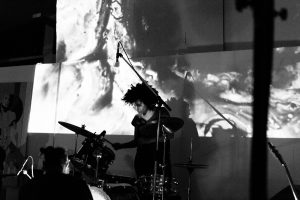
Caitlin speaks calmly, choosing her words carefully. I catch my knee jiggle and my fingers drum impatiently. It has been a rushed morning for me – full of things to do, places to go, people to see, errands to run – and now our Skype-image doesn’t withstand the connection between Cape Town, South Africa and Madison, Wisconsin. So, it is just her voice. I breathe and force myself to focus, relaxing into the pauses between Caitlin’s words. I start to imagine the experiences, places, sounds, and images she describes.
Caitlin, 26, is a painter, illustrator, photographer, drummer, and tattoo-artist based in South Africa. She joined Emergent Art Space in 2013 when she was still studying at the Michaelis School of Fine Art at the University of Cape Town. Since then, she has already participated in two international exhibitions with EAS: “Translations” in 2016, and most recently in “The Last Image Show”. I had the pleasure of speaking to Caitlin about her journey as an artist, how she connects with different media through improvisation, and the need for kindness.
When did you first know that you wanted to make a career out of art?
I think I was in pre-school. I remember sitting in the garden and drawing. I was just sitting at a table and I realized: Wow, I completed something. Maybe it was a picture of a person. Or a house with trees. Kids’ stuff. But something about it felt very fulfilling. I just thought 'I wish I could do this all the time.' But I didn’t know that you could, and that was what artists did.
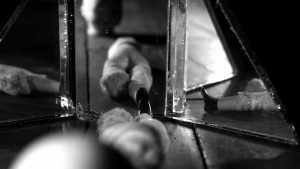
When people asked me "What do you want to do when you grow up?” I just really didn’t relate to any of the usual options like doctor or nurse. For a while I felt like maybe something was wrong with me. There was no word for what I wanted to do. No one in my family knew any artists. They could draw, but they didn’t see it as a career.
I think it was around the age of 16 when I realized I can’t stifle this flame. And I don’t want to. So, I took classes. After high school, I decided to do a degree in fine art. And luckily my family was very supportive. They understand and see my goals.
What helped you form your style? What inspires you? How would you describe your process?
Exposure to different artists. My first exposures to art were to cartoons. Then friends passed on graphic novels. I realized, ok, there are more complex ways to tell a story visually. Dave McKean, for example, was very expressive in terms of texture. There was collage and paint and ink, and layers on top of things in a very dark sort of imagery with a lot of depth in tones.
Music has been a very big influence in terms of how I approach art. Yeah, just being exposed to music and then playing drums. I started when I was 14. I mix music and art, or have the two run in parallel. Experimental and improvised music, this collaborative approach, where it's not about ego and certain people standing out. That philosophy has really affected how I make art. My process is very rarely completely planned out, and quite eclectic.
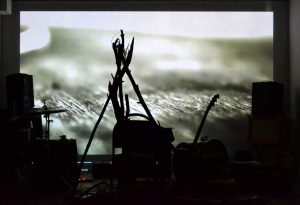
With the band I’m currently in – a Cape Town-based ensemble called Morning Pages – we have a very meditative way of playing with each other. We don’t instruct each other what to play. We’re also very texture based in terms of our sound. So, it’s more like sound scaping, moods, feelings and the journey of it, than about the final product. I think that very much influences how I make art. It’s more about focusing on the subtleties of a line, or of making texture or experimenting with how different mediums interact that would usually never be together. For example, I might use acrylic and then build upon that with ink and tea and a few lines. What turns out is textured and abstract, not necessarily an object. Even though I do tend to like moons (laughs).
It sounds like the creative process, your own experience, is your goal. How do other people connect with that?
I think both with the music of Morning Pages and my artwork, often people connect by linking a personal experience or it evokes some feeling for them. They create their own narratives when they listen to the sounds. So, from that standpoint, it’s always a dialogue. Sometimes it’s like a Rorschach print. People see and discover things in it that I hadn’t seen before. That’s part of the magic of it.
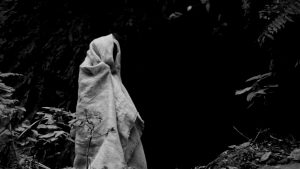
What are topics that are important to you? Which issues do you want to address through your art?
I wonder about what we think is social progression. The space race, for example. We got this idea about going to Mars and colonizing Space. But the history of us shifting into different spaces on this planet hasn’t necessarily been good. We have inflicted ourselves, our ideas and beliefs on others, instead of embracing what we have. In terms of people and nature, we have taken a lot from the earth and destroyed pieces of it. I feel that if we manage to go to another planet, we would be taking that culture with us. We’re not really that big on being renewable. I try to talk about these things. How can we be progressive and productive, but not in such a destructive way?
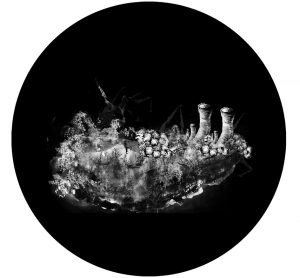
I feel there’s a lack of gentleness sometimes in the way we interact. So, maybe with the textural work, the details and the meditative process, it is a softer approach. Maybe people can find something they are missing in that. You don’t really know until you see an artwork that you needed it, I think. A sound or an image might resonate with you and then you notice “Oh, I’m missing that.”
A lot of what I do, like recently shifting to veganism, has to do with empathy. It’s about not having a hierarchy of yourself over other beings. In South Africa, we are still very much concerned about undoing what happened here. There is a lot of racial tension. Somehow it feels like there isn’t really that much space for talking about letting go of yourself – and just being - without worrying about identity. When I’m not here, nature will still be here. And that’s quite an interesting idea. Like, I don’t really matter. But it’s almost like we don’t take note of that – or notes from that. We don’t see that our hierarchy of things is imbalanced. Someone must have a loss for you to have a gain.
I’m not saying identity isn’t relevant, and that things aren’t unfair. But there is a big gap between how we exploit animals and what we’re saying about exploiting each other. Saying that, because another being can’t speak for itself, it doesn’t have a voice and can’t feel. That is how we used to treat other people. There was a time when people felt that certain people just weren’t worthy of being seen or heard or understood. And I feel like we are still doing that today with other beings.
How do those topics and ideas relate to the pieces you exhibited in the Last Image Show?
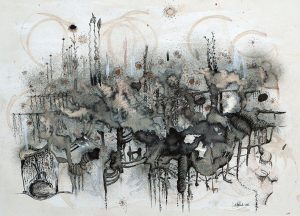
I showed a piece called “Vegetation and Rot”. It had to do with the cycle of life and death. In nature, both are so intertwined. Things are constantly growing and dying in a very chaotic, non-human way. Things grow on top of each other, around each other, into each other. When I look at it, it makes me think of sound. Like this huge wall of sounds with things moving and growing and shifting and changing. But it’s so subtle, gentle and slow at the same time. Maybe that idea of harmony -- of things moving and shifting but being at peace at the same time – is what attracts people to nature
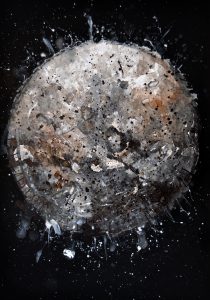
You work with so many different materials including clothing. How do you start something new or approach a different medium?
I like to put things out there first. Somewhere down the line, it might be a trigger for someone. I’ve always wanted to work with clothes. So, one day, I just painted on my shirt and put it online, without really thinking anything would come out of it. But then I got so many responses and requests, I realized that this is something I could do. A T-shirt is not a permanent piece. It’s material you wear all the time. So, I try to make it as easy and affordable as possible. People really want art, especially people my age. But they might not have the capital to get big artworks at gallery prices or buy an original piece. So, clothes seemed like something that I could do where people could have my art, but not pay so much money. Part of my philosophy has been to make it more accessible.
For many emerging artists it is a financial challenge to be a full-time artist. What are strategies that you have developed in order to successfully live from art?
It is tough taking this route. It can definitely be scary at times (laughs). I think that’s partly why I am so spread out and do so many different things, besides being genuinely interested in them. Art sales are very slow generally. This way, I’m not dependent on one source of income.
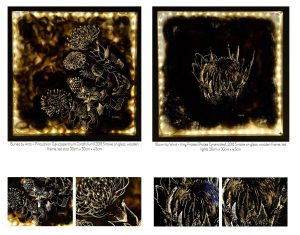
I can have my stuff on Unsung Art, a South African online art store. I can sell my art directly on Instagram or on Facebook. I’ve also done a lot of free-lance work as an assistant for other artists. Maybe someone needs me to do inking for a book, or grey washes, or I assemble something for them.
The internet plays a large role in helping me connect with people, and them reaching out to me. A large network has been slowly developing over the years. Having a lot of things going on is exciting for me. A lot of it happens by chance. A big part of it is handing your work over to others – curators or people that manage small aspects of what you do. Last weekend I gave all my pieces to Unsung Art to have them sold online. I’m also giving away illustrations. Not having the burden of selling them gives me the freedom to focus on other things.
Where do you see your work going next?
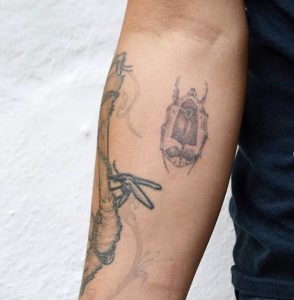
I’ve always been interested in tattooing. I just never knew how to approach it. Then, recently, I came across hand-poked tattooing online. I realized that this is very possible and can still be done in a professional way, and I can keep my materials completely vegan.
I’ve started working on translating my style into dot work imagery. And I’ve already done some first tattoos on myself and on other people. Until now it’s been very object-based images, like a tooth or a bee. Maybe in the future, I can do more abstract or improvised images as well. I think that still needs some more time before I can confidently improvise on a person.
When tattooing, you’re totally aware of the other person, because now pain is involved. So there is a different temporality to it than when working on paper. Even if hand poking is much gentler than machine tattooing. So, working fast is something I need to get used to for tattooing.
Do you have any questions for the Emergent Art Space community?
I would love to know if anyone is doing similar stuff. Do they resonate with nature? What are their meditative processes? Do they work in a different genre with a similar feeling in mind? I also enjoy connecting with people that are quietly working on pieces that are still underground, not yet published. Because that is a very different, raw headspace.
-----------
When Caitlin and I say goodbye, something has changed. I look around, bringing myself back to Madison, Wisconsin, and I check my watch. Has it really been two hours?
-----------
To learn more about Caitlin’s work, visit her website here, her Soundcloud here, and Youtube here.